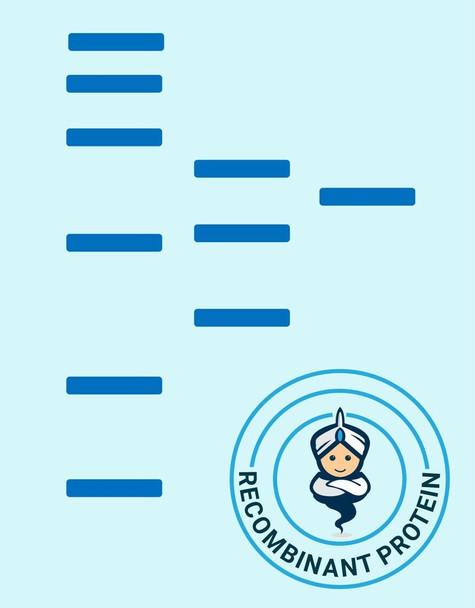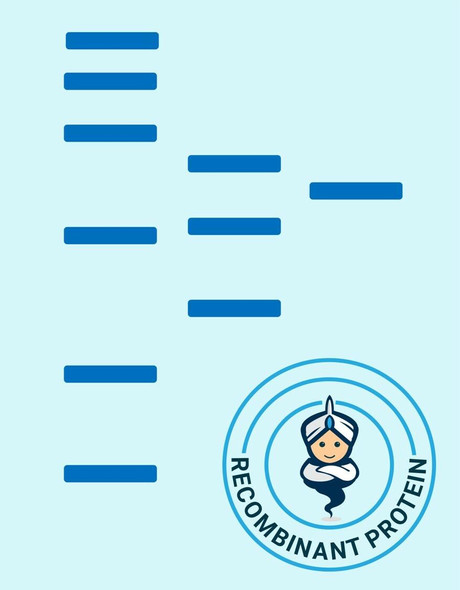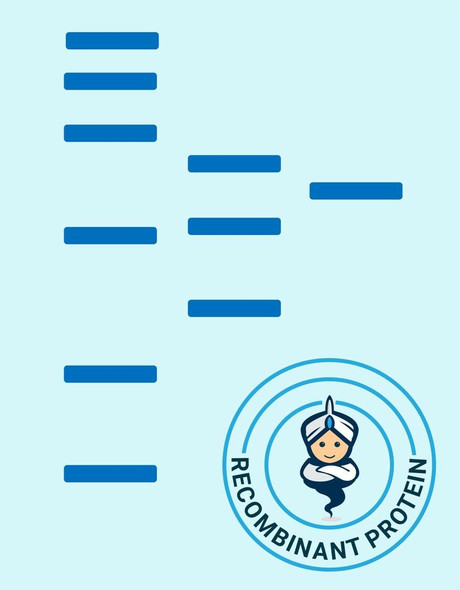Human GRO g Recombinant Protein (RPPB1152)
- SKU:
- RPPB1152
- Product type:
- Recombinant Protein
- Size:
- 10ug
- Species:
- Human
- Target:
- GRO g
- Synonyms:
- Macrophage inflammatory protein 2-beta
- MIP2-beta
- CXCL3
- Growth-regulated protein gamma
- Source:
- Escherichia Coli
- Uniprot:
- P19876
Description
| Product Name: | Human GRO g Recombinant Protein |
| Product Code: | RPPB1152 |
| Size: | 10µg |
| Species: | Human |
| Target: | GRO g |
| Synonyms: | Macrophage inflammatory protein 2-beta, MIP2-beta, CXCL3, Growth-regulated protein gamma, GRO-gamma, GRO-gamma(1-73), GRO3, GROg, MIP2B, SCYB3, MIP-2b, CINC-2b, MGSA gamma. |
| Source: | Escherichia Coli |
| Physical Appearance: | Sterile Filtered colorless solution. |
| Formulation: | The CXCL3 protein is formulated in 20mM Tris-HCl buffer pH-8, 1mM DTT and 20% glycerol. |
| Stability: | Liquid CXCL3 although stable at 10°C for 1 week, should be stored below -18°C. For long term storage it is recommended to add a carrier protein (0.1% HSA or BSA).Please prevent freeze-thaw cycles. |
| Purity: | Greater than 95.0% as determined by SDS-PAGE. |
| Amino Acid Sequence: | MGSSHHHHHH SSGLVPRGSH MASVVTELRC QCLQTLQGIH LKNIQSVNVR SPGPHCAQTE VIATLKNGKK ACLNPASPMV QKIIEKILNKGSTN |
Chemokine (C-X-C motif) ligand 3 (CXCL3) is a small cytokine belonging to the CXC chemokine family that is also known as GRO3 oncogene (GRO3), GRO protein gamma (GROg) and macrophage inflammatory protein-2-beta (MIP2b). CXCL3 controls migration and adhesion of monocytes and mediates it effects on its target cell by interacting with a cell surface chemokine receptor called CXCR2. The gene for CXCL3 is located on chromosome 4 in a cluster of other CXC chemokines.
GRO-Gamma Human Recombinant produced in E.Coli is a single,non-glycosylated, polypeptide chain containing 94 amino acids (35-107) and having a molecular mass of 7902 Dalton. The GRO-g is fused to 20 amino acid His-Tag at N-Terminus and purified by proprietary chromatographic techniques.
| UniProt Protein Function: | CXCL3: Ligand for CXCR2. Has chemotactic activity for neutrophils. May play a role in inflammation and exert its effects on endothelial cells in an autocrine fashion. In vitro, the processed form GRO-gamma(5-73) shows a fivefold higher chemotactic activity for neutrophilic granulocytes. Belongs to the intercrine alpha (chemokine CxC) family. |
| UniProt Protein Details: | Protein type:Motility/polarity/chemotaxis; Secreted; Secreted, signal peptide Chromosomal Location of Human Ortholog: 4q21 Cellular Component: extracellular space; extracellular region Molecular Function:chemokine activity; CXCR chemokine receptor binding Biological Process: G-protein coupled receptor protein signaling pathway; neutrophil chemotaxis; response to lipopolysaccharide; positive regulation of leukocyte chemotaxis; immune response; inflammatory response; regulation of cell proliferation |
| NCBI Summary: | This antimicrobial gene encodes a member of the CXC subfamily of chemokines. The encoded protein is a secreted growth factor that signals through the G-protein coupled receptor, CXC receptor 2. This protein plays a role in inflammation and as a chemoattractant for neutrophils. [provided by RefSeq, Sep 2014] |
| UniProt Code: | P19876 |
| NCBI GenInfo Identifier: | 127086 |
| NCBI Gene ID: | 2921 |
| NCBI Accession: | P19876.1 |
| UniProt Secondary Accession: | P19876,Q4W5H9, |
| UniProt Related Accession: | P19876 |
| Molecular Weight: | 11,342 Da |
| NCBI Full Name: | C-X-C motif chemokine 3 |
| NCBI Synonym Full Names: | chemokine (C-X-C motif) ligand 3 |
| NCBI Official Symbol: | CXCL3 |
| NCBI Official Synonym Symbols: | GRO3; GROg; MIP2B; SCYB3; MIP-2b; CINC-2b |
| NCBI Protein Information: | C-X-C motif chemokine 3; GRO-gamma; MIP2-beta; MGSA gamma; GRO3 oncogene; GRO-gamma(1-73); growth-regulated protein gamma; macrophage inflammatory protein 2-beta; melanoma growth stimulatory activity gamma |
| UniProt Protein Name: | C-X-C motif chemokine 3 |
| UniProt Synonym Protein Names: | GRO-gamma(1-73); Growth-regulated protein gamma; GRO-gamma; Macrophage inflammatory protein 2-beta; MIP2-beta |
| UniProt Gene Name: | CXCL3 |
| UniProt Entry Name: | CXCL3_HUMAN |










